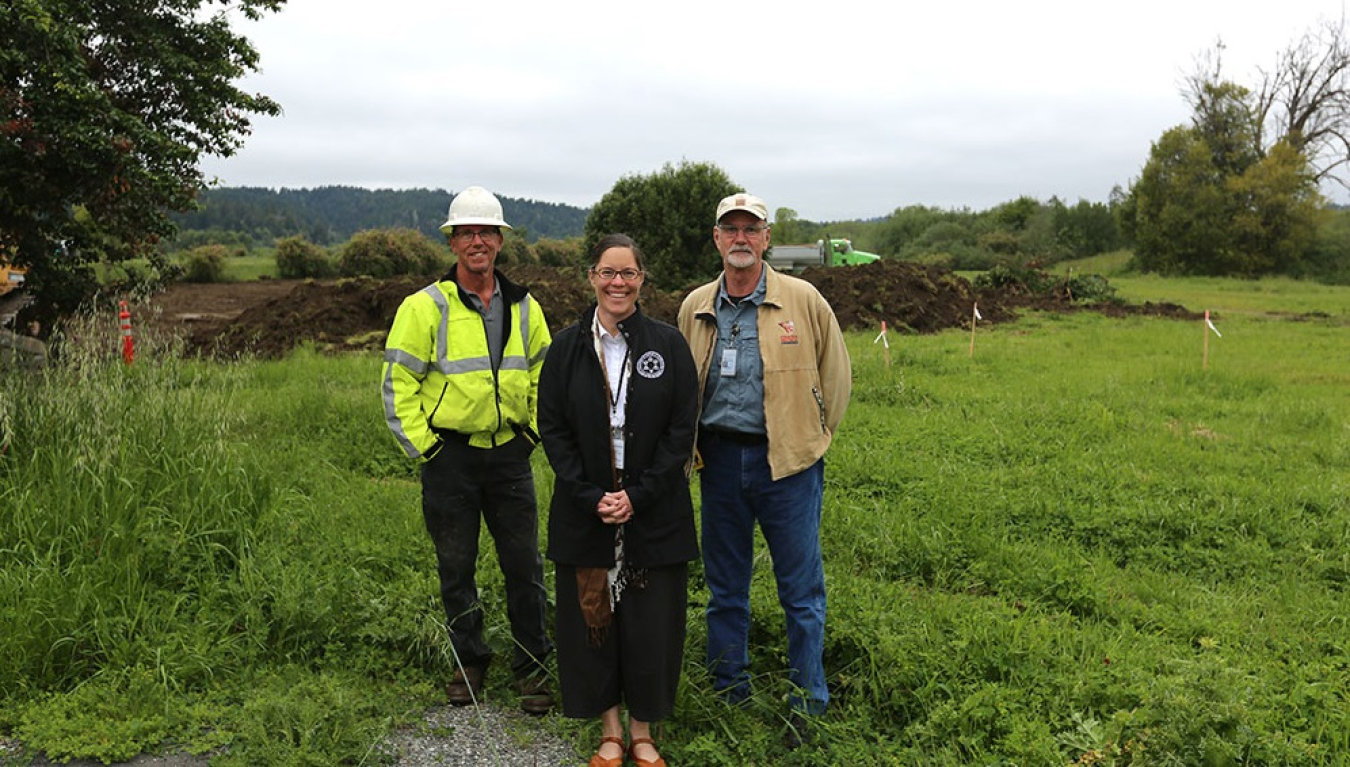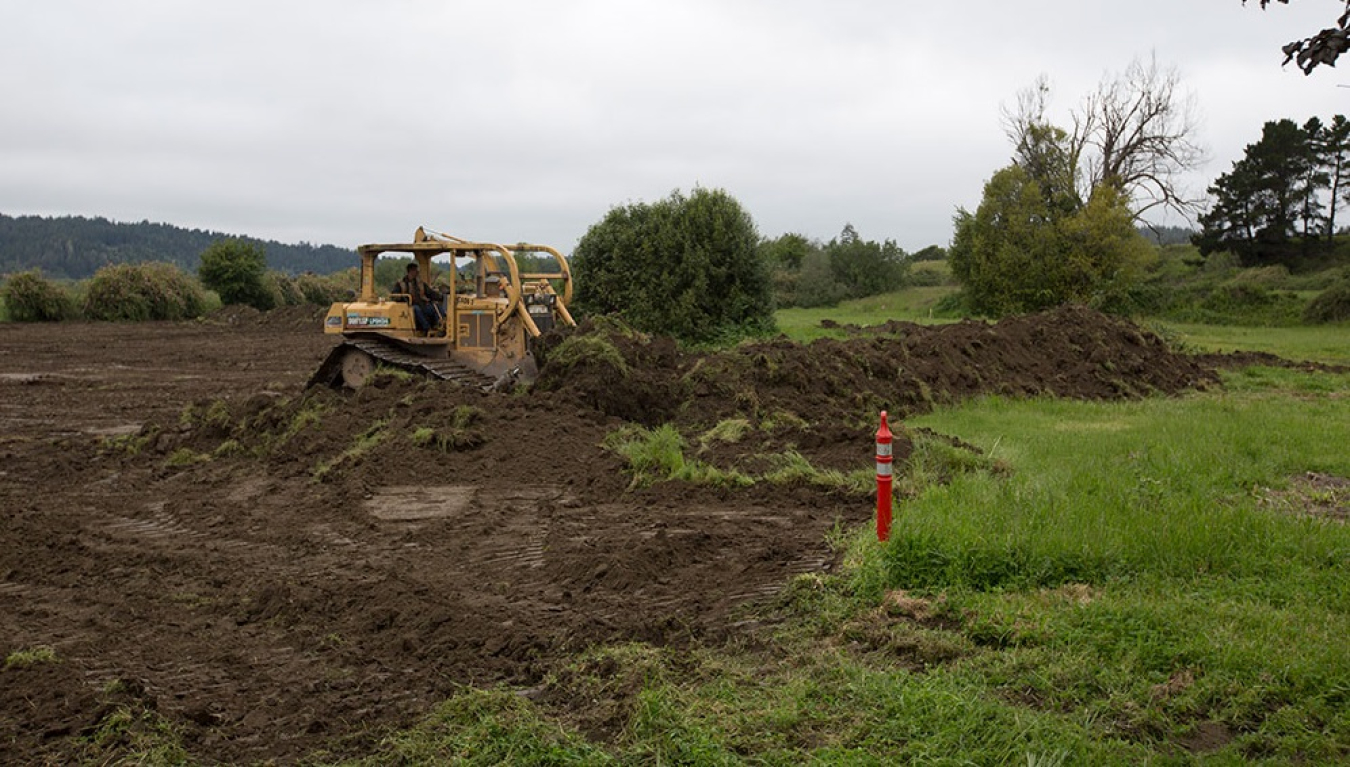
Blue Lake Rancheria Energy Director Jana Ganion flanked by Kernen Construction Site Supervisor Gavin Johnson (left) and Blue Lake Rancheria Facilities Director Neil Harris (right). Photo from Blue Lake Rancheria
Blue Lake Rancheria's Bold Action on the Climate Front Pays Dividends
Blue Lake Rancheria, a small Northern California Tribe, developed its holistic strategic climate action plan in 2008. Demonstrating the power of a driving vision, the Tribe has since mobilized every resource at its disposal to advance a leading-edge strategy for eliminating its carbon footprint while bolstering climate resiliency. To date, the Tribe has reduced energy consumption by 35% and has committed to reduce greenhouse gas emissions 40% by 2018, utilizing a range of approaches including the use of biodiesel to power public buses and aggressive energy efficiency measures. In recognition of their extraordinary leadership on the climate front, Blue Lake Rancheria earned the distinction of being among the 16 communities designated as White House Climate Action Champions.
The Blue Lake Rancheria (Tribe) is on the fast track to a clean energy future, and on May 3, 2016, the Tribe hit a new milestone as construction of its 500-kilowatt (kW) solar array got underway. The solar system is a cornerstone of the Tribe’s low-carbon, community-scale microgrid project, scheduled to be online by year-end.
When complete, the microgrid project will include more than 950 kilowatt-hours of battery storage, which will be incorporated with the Tribe’s existing back-up generators. “A key function of the microgrid project is the ability to layer in solar and battery storage,” said Blue Lake Rancheria Energy Director Jana Ganion.
The microgrid will power the Tribe’s government offices, casino, hotel, and event center while providing energy savings through peak shaving and demand response during business-as-usual situations. It will also enable the Tribe to serve as an evacuation site and long-term emergency operations center for the region.
Compounding the excitement of the solar array construction, Blue Lake Rancheria recently attained approval from the California Public Utilities Commission (CPUC) to purchase the Pacific Gas & Electric Company (PG&E) infrastructure needed to make their microgrid project work. This infrastructure purchase not only includes services to six tribal buildings, it allows the Tribe to control the configuration of the infrastructure and the power generation, as well as the distribution to and from their facilities, in a way that works best in any given situation.
In addition to securing grant funding for the microgrid and solar array through the California Energy Commission’s Electric Program Investment Charge (EPIC), and receiving technical assistance through the U.S. Department of Energy (DOE) Office of Indian Energy’s Strategic Technical Assistance Response Team (START) Program, the Tribe has also benefited from cultivating healthy partnerships with a broad array of other regional and national partners from industry, government, and academia.

Kernen Heavy Equipment Operator Aaron Ashcorn begins grading the construction site in preparation for the installation of Blue Lake Rancheria’s 500-kW solar array. Photo from Blue Lake Rancheria
“None of this would be possible without the extraordinary engineering, project leadership, stamina, and 'solve-any-problem-approach' provided by the Schatz Energy Research Center (SERC) team at Humboldt State University; the diligence and expertise of the PG&E team; the global leadership and stewardship exemplified by the CPUC; and the support and funding provided by the California Energy Commission, which it is literally and figuratively EPIC,” said Ganion.
Ganion also extolled the evolving contributions of the Tribe’s “top-tier technical partners,” including Kernen Construction, Colburn Electric, Siemens, Tesla, REC Solar, and the Office of Indian Energy, as well as DOE’s National Renewable Energy Laboratory and Idaho National Laboratory (INL). “INL was the first champion of this project, and their microgrid hardware-in-loop testing expertise really brought microgrids to our attention,” explained Ganion.
While celebrating the headway the Tribe and its partners are making, Ganion’s hopeful progress update also underscored the urgency of their collaborative undertaking. “While national and international climate discussions swirl at their own pace, we are implementing renewable energy and driving down greenhouse gas emissions as fast as possible,” she said. “There is no time to waste.”
In the spirit of collaboration, Blue Lake Rancheria is also a member of DOE’s Indian Country Energy and Infrastructure Working Group, which brings government and tribal leaders together to discuss real-time tribal experiences representing obstacles and opportunities in energy and related infrastructure development and capacity building in Indian Country.
For more information, read a blog about Blue Lake Rancheria’s bold action on the climate front and visit the U.S. Climate Resiliency Toolkit page on Blue Lake Rancheria’s innovative action to reduce the causes of climate change. Also watch a public service announcement about the Tribe’s microgrid.
